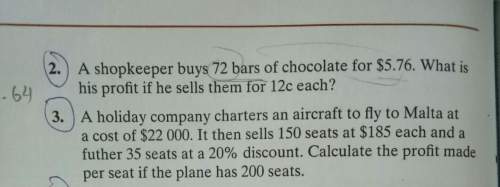
Mathematics, 23.11.2019 23:31 rubencharomarti
Aphotographer wants to capture polaris, the north star, and the surrounding stars without capturing any “star trails” caused by the rotation of the earth. he needs to use a long exposure (keep the shutter open for an extended period of time) to ensure that the stars show up bright and clear, but he will need his camera to rotate at the same rate as the earth to prevent the star trails from appearing in the photos. stars appear to rotate about polaris at a rate of 1 4 ° per minute. you can use this rate to write and solve equations. the photographer says that the stars will rotate a total of 15° while his camera shutter is open. the equation 1 4 s=15 , where s is the length of time in minutes the shutter remains open, represents this situation. how long will the photographer’s camera shutter be open?

Answers: 1


Another question on Mathematics

Mathematics, 21.06.2019 15:30
What is the length of the missing leg in this right triangle? 18 mm 24 mm 26 mm 32 mm
Answers: 1

Mathematics, 21.06.2019 19:00
If (x-2) 2= 49, then x could be a. -9 b. -7 c.- 2 d. 5 e.9
Answers: 2

Mathematics, 21.06.2019 22:10
Given: ae ≅ ce ; de ≅ be prove: abcd is a parallelogram. we have that ab || dc. by a similar argument used to prove that △aeb ≅ △ced, we can show that △ ≅ △ceb by. so, ∠cad ≅ ∠ by cpctc. therefore, ad || bc by the converse of the theorem. since both pair of opposite sides are parallel, quadrilateral abcd is a parallelogram.
Answers: 1

Mathematics, 21.06.2019 23:00
According to the general equation for conditional probability if p(anb)=3/7 and p(b)=7/8 what is p(a i b)
Answers: 1
You know the right answer?
Aphotographer wants to capture polaris, the north star, and the surrounding stars without capturing...
Questions

English, 19.12.2020 05:20

Mathematics, 19.12.2020 05:20




Mathematics, 19.12.2020 05:20

History, 19.12.2020 05:20



Advanced Placement (AP), 19.12.2020 05:20


History, 19.12.2020 05:20

Mathematics, 19.12.2020 05:20

Mathematics, 19.12.2020 05:20

Mathematics, 19.12.2020 05:20




Mathematics, 19.12.2020 05:20

Mathematics, 19.12.2020 05:20




